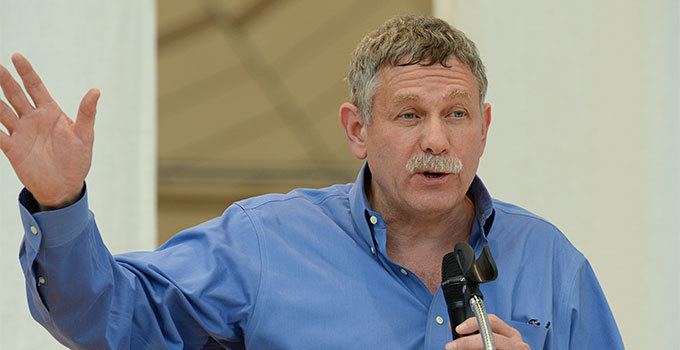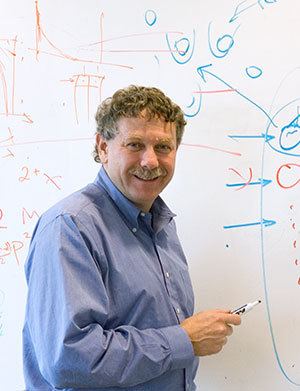Name Eric Lander | ||
 | ||
Alma mater Princeton UniversityUniversity of Oxford Books Symmetric Designs: An Algebraic Approach Notable awards MacArthur Fellowship, Woodrow Wilson Awards Similar People | ||
Alternative approaches to molecular biology mit 7 01sc fundamentals of biology
Eric Steven Lander (born February 3, 1957), a mathematician and geneticist, is a Professor of Biology at the Massachusetts Institute of Technology (MIT), former member of the Whitehead Institute, and founding director of the Broad Institute of MIT and Harvard who has devoted his career to realizing the promise of the human genome for medicine. He was co-chair of U.S. President Barack Obama's Council of Advisors on Science and Technology.
Contents
- Alternative approaches to molecular biology mit 7 01sc fundamentals of biology
- Eric lander the genesis of genius
- Early life and education
- Early mathematical career
- Contributions to genomics
- Beyond genomics
- Teaching
- Translational ventures
- Forensic Science and Criminal Justice
- Media appearances
- Recognition and service
- Selected works
- References

Eric lander the genesis of genius
Early life and education

Lander was raised in a Jewish family, the son of Harold and Rhoda Lander who were both lawyers. He was captain of the math team at Stuyvesant High School and an International Mathematical Olympiad Silver Medalist for the United States, graduating from high school in 1974. He attended the Hampshire College Summer Studies in Mathematics program. At the age of seventeen, he wrote a paper on quasiperfect numbers for which he won the Westinghouse Prize.

Lander attended Princeton University, where he graduated in 1978 as valedictorian. He then attended the University of Oxford as a Rhodes Scholar, and he wrote his doctoral D.Phil. thesis on algebraic coding theory and symmetric block designs, under the supervision of Peter Cameron.
Early mathematical career

As a mathematician, Lander studied combinatorics and applications of representation theory to coding theory. He enjoyed mathematics, but did not wish to spend his life in such a "monastic" career. Unsure of what to do next, he took up a job teaching managerial economics at Harvard Business School; Lander also began writing a book on information theory. At the suggestion of his brother, developmental biologist Arthur Lander, he started to look at neurobiology "because there's a lot of information in the brain." In order to understand mathematical neurobiology, he felt he had to study cellular neurobiology; in turn, this led to studying microbiology and eventually, genetics. "When I finally feel I have learned genetics, I should get back to these other problems. But I'm still trying to get the genetics right."

He later became acquainted with David Botstein, a geneticist working at MIT. Botstein was working on a way to unravel how subtle differences in complex genetic systems can become disorders like cancer, diabetes, schizophrenia, and even obesity. The two collaborated to develop a computer algorithm to analyze the maps of genes. Lander then joined the Whitehead Institute in 1986; that same year, he became an assistant professor at MIT. Lander was awarded the prestigious MacArthur Fellowship in 1987. In 1990, he founded the Whitehead Institute/MIT Center for Genome Research (WICGR). The WICGR became one of the world's leading centers of genome research, and under Lander's leadership, it made great progress in developing new methods of analyzing mammalian genomes. It also made important breakthroughs in applying this information to the study of human genetic variation, and formed the basis for the foundation of the Broad Institute—a transformation that Lander spearheaded.
Contributions to genomics
There were two main groups attempting to sequence the human genome: the first was the Human Genome Project (HGP), a publicly funded effort that intended to publish the information it obtained freely and without restrictions. Many research groups from countries all over the world were involved in this collaborative effort. The second effort was undertaken by Celera Genomics, which intended to patent the information obtained and charge subscriptions for use of the sequence data. (Celera has since abandoned this policy and has donated large amounts of sequence information for free public use.) Established first, the HGP moved slowly in the early phases of research as the role of the Department of Energy was unclear and sequencing technology was in its infancy. When Celera entered the race to discover the genome, the pressure was on the HGP to establish as much of the genome in the public domain as quickly as possible. This was a change of strategy for the HGP, because many scientists at the time wanted a more complete copy of the genome. Along with other members of the HGP, Lander pushed for quicker discovery so that genes would not be discovered and patented by Celera first.
In 2001, a draft of the human genome was published in the journal Nature. The Whitehead Institute for Biomedical Research, Center for Genome Research, was listed first (the order was according to total genomic sequence contributed). Lander was the first author named.
The WICGR has also made a leading contribution to the sequencing of the mouse genome. Aside from academic interest this is an important step in fully understanding the molecular biology of mice which are often used as model organisms in studies of everything from human diseases to embryonic development. Increased understanding of mice will thus facilitate many areas of research. The WICGR has also sequenced the genomes of Ciona savignyi (sea squirt), the pufferfish, the filamentous fungus Neurospora crassa, and multiple relatives of Saccharomyces cerevisiae, one of the most studied yeasts. The Ciona savignyi genome provides a good system for exploring the evolutionary origins of all vertebrates. Pufferfish have smaller-sized genomes compared to other vertebrates; as a result, their genomes are "mini" models for vertebrates. The sequencing of the yeasts related to Saccharomyces cerevisiae will ease the identification of key gene regulatory elements some of which may be common to all eukaryotes (including both plant and animal kingdoms).
Beyond genomics
Sequence data is just that: a list of bases found in a given stretch of DNA. Its value lies in the discoveries and new technologies it allows. In Lander's case, one of these applications is the study of disease. He is the founder and director of the Broad Institute, a collaboration between MIT, Harvard, the Whitehead institute and affiliated hospitals. Its goal is "to create tools for genome medicine and make them broadly available to the scientific community; to apply these tools to propel the understanding and treatment of disease". To this end they are studying the variation in the human genome and have led an international effort which has assembled a library of 2.1 million single-nucleotide polymorphisms (SNP). These act as markers or signposts in the genome allowing the identification of disease susceptibility genes. They hope to construct a map of the human genome using blocks of these SNP called Linkage disequilibrium or LD. This map will be of significant help in medical genetics. It will allow researchers to link a given condition to a given gene or set of genes using the LD as a marker. This will allow for improved diagnostic procedures. Lander and his colleagues are hoping the LD map will allow them to test the Common Disease-Common Variant hypothesis which states that many common diseases may be caused by a small number of common alleles, for example 50% of the variance in susceptibility to Alzheimer's disease is explained by the common allele ApoE4. Lander's group have recently discovered an important association that accounts for a large proportion of population risk for adult onset diabetes.
Lander's most important work may be his development of a molecular taxonomy for cancers. The cancers are grouped according to gene expression and information like their response to chemotherapy is collected for each group. The division of cancers into homogeneous subgroups will allow increased understanding of the molecular origins of these cancers and aid the design of more effective therapies. They have also identified a new type of leukemia called MLL and have identified a gene which may serve as a target for a new drug.
Teaching
In addition to his research, he has for several years co-taught MIT's required undergraduate introductory biology course (7.012) with Robert Weinberg. Since 2013, he is also teaching on an online course "7.00x Introduction to Biology - The Secret of Life" via the EdX platform.
Translational ventures
Lander is a founding advisor of Foundation Medicine, a company that aims to bring comprehensive cancer genomic analysis to routine clinical care. He is also a co-founder of Verastem, biopharmaceutical company focused on discovering and developing drugs to treat cancer by targeting cancer stem cells.
Forensic Science and Criminal Justice
In 1989, Lander provided expert testimony in a criminal case: People v. Castro in New York. He showed that the then-current method of interpreting DNA evidence was flawed, and liable to give false positive matches, implicating innocent defendants. Two of the defense lawyers in that case, Peter Neufeld and Barry Scheck, went on to found the Innocence Project, an organization which uses DNA analysis to exonerate wrongly-convicted prisoners. Lander is a member of the board of directors.
Media appearances
Lander was named one of Time magazine's 100 most influential people of our time (2004) for his work on the HGP. Lander has also appeared in numerous PBS documentaries about genetics. He was listed at #2 on the MIT150 list of the top 150 innovators and ideas from MIT.
Recognition and service
In December 2008, he was named, along with Harold E. Varmus, one of the co-chairs of the Council of Advisors on Science and Technology in the Obama administration.in 2012 he was awarded the Dan David Prize.
Lander is also a member of the USA Science and Engineering Festival's Advisory Board.
On February 6, 2017, Lander received a honoris causa doctorate from the Université catholique de Louvain.
